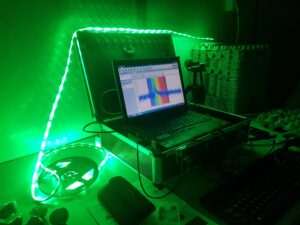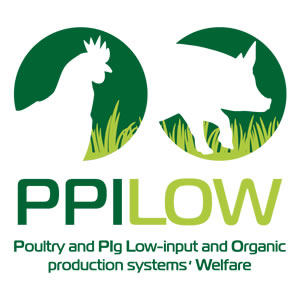PPILOW scientific publications
1: Detection of Trichinella spp. larvae in domestic pigs (Sus scrofa domesticus) and golden jackals (Canis aureus) using artificial digestion and a microfluidic device: a comparative study – by Vasile Cozma and Zsolt Boros (USAMV)
Nematodes of genus Trichinella are zoonotic parasites and are among the most widespread parasites of swine, badgers, bears and predatory animals like wolfs, foxes or jackals. This study aimed to compare the detection capacity (for Trichinella spp. larvae) of artificial digestion and an experimental microfluidic device. A total of 20 samples positive for Trichinella spp. in trichinoscopy (10 domestic pigs and 10 golden jackals) were tested (5 g/animal) with both artificial digestion method and a microfluidic device. Artificial digestion is the gold standard method for direct detection of Trichinella larvae in meat samples. A microfluidic device is a new approach regarding Trichinella spp. detection, and in this study, a newly designed experimental device was used (Bionics Biomicrofuidics lab, Budapest). All of the tested pig and golden jackal samples came out positive in the artificial digestion method, but also in the microfluidic device. The total number of counted larvae was significantly higher in artificial digestion (695 larvae in jackals; 486 larvae in pigs) than in the microfluidic device method (291 larvae in jackals; 263 larvae in pigs). When the experimental device was used, the larval structure was more visible than in the golden standard method. The results described here indicate that the microfluidic device can be used in the direct detection of Trichinella larvae in domestic and wild animals, allowing the visualization of their structure, but it’s not as efficient as artificial digestion in counting the number of larvae.
Detection of Trichinella spp. larvae in domestic pigs (Sus scrofa domesticus) and golden jackals (Canis aureus) using artificial digestion and a microfluidic device: a comparative study. Zsolt Boros, András József Laki, Luciana Cătălina Panait, Călin Gherman, Vasile Cozma. Sci Parasitol., 2023,24 (1-2): 9-15, ISSN 1582-1366.
2: Green light during incubation does not negatively affect hatching characteristics in brown and white laying hens – by Saskia Kliphuis (UU)

Light transmission measurements – © UU

Hatching chicks – © UU
An exciting paper was published last summer regarding the effects of green LED light during incubation on hatching characteristics in brown and white laying hens. This study was conducted by colleagues from the ChickenStress European Training Network and the Utrecht University partners of the PPILOW project. Providing light during incubation is a promising method to improve welfare in later life in poultry, because it would more closely approximate chicken natural environment compared to the current incubation in darkness. So far, little is known about the effects, either positive or negative, of light during incubation on hatching characteristics. We investigated the effects of this incubation method (hatch time, hatchability, chick quality, body weight and embryonic age of death) in two different laying hen hybrids. Dekalb White (DW) and ISA Brown (ISA) eggs were incubated in complete darkness or in a light: dark cycle of 12L:12D throughout incubation. First, light transmission through the eggshell was measured through 27 eggs. Then, the effects of light during incubation on hatching characteristics were investigated on 711 chicks. Light during incubation had no effects on hatching characteristics. Even though light transmission was higher through white eggshells than through brown eggshells, this did not cause any differences in hatching characteristics. There were some differences between brown and white hybrids, regardless of the light treatment: hatch time was longer and navel quality was better in DW than in ISA, while body weight and embryonic age of death were lower in DW than in ISA. To conclude, green light during incubation did not negatively affect hatching characteristics in either DW nor ISA laying hen hybrids. Future research should therefore focus on its potential benefits for laying hen welfare.
Green light during incubation: effects on hatching characteristics in brown and white laying hens. Manet, M. W., Kliphuis, S., van den Brand, H., Nordquist, R. E., Goerlich, V. C., & Rodenburg, T. B. (2023). Livestock Science, 105270. https://doi.org/10.1016/j.livsci.2023.105270
3: 1) The Effects of Coriandrum sativum L. and Cucurbita pepo L. against Gastrointestinal Parasites in Swine: an In Vivo Study; 2) The In Vitro Anticoccidial Activity of Some Herbal Extracts against Eimeria spp. Oocysts Isolated from Piglets – Vasile Cozma and Marina Spinu (USAMV)
Swine, as other domestic farmed species are prone to parasitic diseases, which cause major damage to their welfare and health in conjunction with a substantial economic impact on the farmer. In low input systems, the traditional use of medicinal or aromatic plants helped the prevention but also cure of parasitic diseases, in some instances along with the impairment of pathogenic bacteria growth and enhancement of immune response against aggressors. Nevertheless, the scientific substantiation of such uses of medicinal plants are scarce in some cases. Therefore, in this study, the antiparasitic potential of Cucurbita pepo L. and Coriandrum sativum L. against protozoa and nematodes found in swine was tested. The main age and production categories of pigs (weaners, fatteners and sows) were targeted, from which feces/rectal swabs were collected. The samples were subjected to flotation (Willis and McMaster), active sedimentation, Ziehl-Neelsen stain modified by Henricksen, modified Blagg and eggs/oocysts culture techniques. The identified parasite panel included, depending on age category, Ascaris suum, Trichuris suis, Oesophagostomum spp., Balantioides coli (syn. Balantidium coli), Eimeria spp. and Cryptosporidium spp. The effects observed after the administration for ten consecutive days of 500 mg/kg bw/day of powdered C. pepo and of 170 mg/kg bw/day of powdered C. sativum were pronounced anthelminthic for the pumpkin and antiprotozoal for the coriander against the abovementioned parasites. Such results, meanwhile representing data within the first Romanian report on the in vivo antiparasitic activity of both plants, provide small farmers that keep their animals in low-input and free-range systems with potential natural, highly bioavailable and economic resources to control the health of their herds. As in traditional medicine, aromatic plants were often used to combat coccidiae, this study aimed at investigating the in vitro anticoccidial effects of Allium sativum L. (garlic), Artemisia absinthium L. (wormwood), Coriandrum sativum L. (coriander), Cucurbita pepo L. (pumpkin), Satureja hortensis L. (summer savory), and Calendula officinalis L. (marigold) against Eimeria suis and Eimeria debliecki oocysts. For that a stock solution of oocysts (58% E. suis + 42% E. debliecki) was used after three days of incubation, without any supplementation. The unsporulated Eimeria spp. oocysts were co-incubated in a 3 mL well plate for 96 h at 27 °C with serial dilutions of alcoholic plant extracts (5%, 2.5%, 1.25%, 0.625%, and 0.312%). To monitor the effects of the extracts’ concentrations on the oocysts, their sporulation and destruction percentage was recorded every 24 h, for four days. The sporulation of the oocysts was significantly (p = 0.05) inhibited (3.6% sporulated oocysts) by the 5% marigold extract, which also had the highest destructive effect (65.2% destroyed oocysts). Although all plants were effective when compared to control cultures, the results indicated the marigold extract as the most valuable, followed by the wormwood, coriander, garlic, pumpkin, and summer savory extracts. This investigation could represent a first step in the obtainment of a range of natural disinfectants active against Eimeria oocysts as contaminants of swine.

Figure 1. Unsporulated (a), sporulated (b), and destroyed oocyst of Eimeria suis (400×). The concentration of 50 mg/mL of each APE produces complete oocyst wall destruction (c).
The Effects of Coriandrum sativum L. and Cucurbita pepo L. against Gastrointestinal Parasites in Swine: An In Vivo Study. Băieş, M-H.; Cotuţiu, V-D.; Spînu, M.; Mathe, A.; Cozma-Petrut, A.; Miere, D.; Bolboacǎ, S.D.; Cozma, V., Microorganisms 2023, 11, 1230. https://doi.org/10.3390/ microorganisms11051230
The In Vitro Anticoccidial Activity of Some Herbal Extracts against Eimeria spp. Oocysts Isolated from Piglets: Baies, M.-H.; Györke, A.; Cotutiu, V.-D.; Boros, Z.; Cozma-Petrut, , A.; Filip, L.; Vlase, L.; Vlase, A.-M.; Crisan, G.; Spînu, M.; Cozma V., Pathogens 2023, 12, 258. https://doi.org/10.3390/pathogens12020258
4: Behavioural indicators of range use in four broiler strains – by Claire Bonnefous (INRAE)
A specificity of organic chicken meat production is the mandatory outdoor access where animals can express their natural behaviours, such as foraging or exploring. However, range use is highly variable among animals of the same flock. Hence there is a need to better understand the individual factors and potential predictors related to range use. On the one hand, our results confirm that range use is a personality trait in all four studied strains as it differs between individuals but shows within-individual consistency over time. On the other hand, social motivation and boldness seem to be personality traits only in certain strains. Conducting both individual behavioural tests and direct observations before range access, we observed differences in early behaviours by strains and very few significant correlations with range use. While the foraging behaviour positively correlated (significantly or only a tendency) in three strains, no early behaviour correlated with range use in all four studied strains. Therefore, early behaviour did not predict range use in our conditions, but the foraging behaviour calls for further investigation.

Behavioural indicators of range use in four broiler strains. Bonnefous, C., Calandreau, L., Le Bihan-Duval, E., Ferreira, V.H.B, Barbin, A., Collin, A., Reverchon, M., Germain, K., Ravon, L., Kruger, N., Mignon-Grasteau, S., & Guesdon, V. (2023). Applied Animal Behaviour Science, 260(105870). https://doi.org/10.1016/j.applanim.2023.105870

